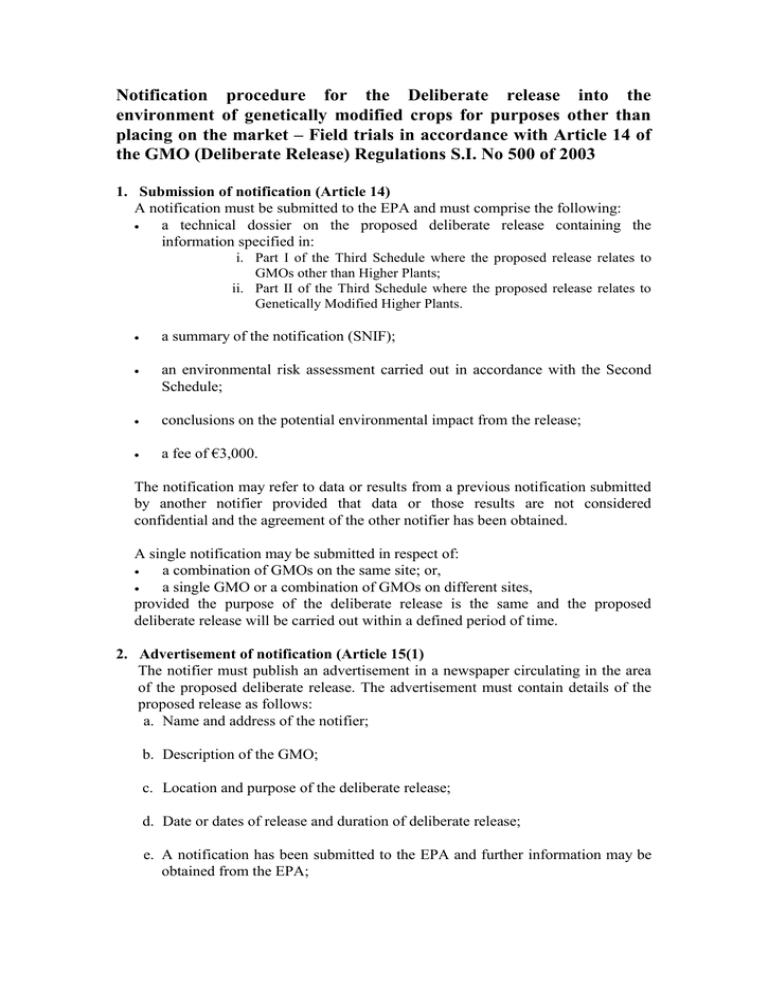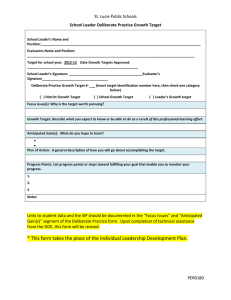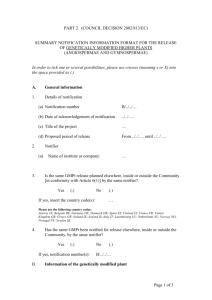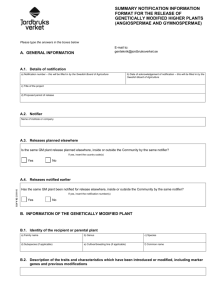Notification procedure for the Deliberate release... environment of genetically modified crops for...
advertisement

Notification procedure for the Deliberate release into the environment of genetically modified crops for purposes other than placing on the market – Field trials in accordance with Article 14 of the GMO (Deliberate Release) Regulations S.I. No 500 of 2003 1. Submission of notification (Article 14) A notification must be submitted to the EPA and must comprise the following: a technical dossier on the proposed deliberate release containing the information specified in: i. Part I of the Third Schedule where the proposed release relates to GMOs other than Higher Plants; ii. Part II of the Third Schedule where the proposed release relates to Genetically Modified Higher Plants. a summary of the notification (SNIF); an environmental risk assessment carried out in accordance with the Second Schedule; conclusions on the potential environmental impact from the release; a fee of €3,000. The notification may refer to data or results from a previous notification submitted by another notifier provided that data or those results are not considered confidential and the agreement of the other notifier has been obtained. A single notification may be submitted in respect of: a combination of GMOs on the same site; or, a single GMO or a combination of GMOs on different sites, provided the purpose of the deliberate release is the same and the proposed deliberate release will be carried out within a defined period of time. 2. Advertisement of notification (Article 15(1) The notifier must publish an advertisement in a newspaper circulating in the area of the proposed deliberate release. The advertisement must contain details of the proposed release as follows: a. Name and address of the notifier; b. Description of the GMO; c. Location and purpose of the deliberate release; d. Date or dates of release and duration of deliberate release; e. A notification has been submitted to the EPA and further information may be obtained from the EPA; f. any person may make a representation on the proposed deliberate release, in writing to the EPA, within a period of 28 days, commencing the date of publication of the advertisement; g. the advertisement must contain: the heading “PROPOSED DELIBERATE RELEASE OF A GENETICALLY MODIFIED ORGANISM”; the full title of the Agency (Environmental Protection Agency) and the full postal address of its headquarters. Within 14 days of receipt of the notification by the Agency the notifier must send a copy of the notice to: the owner of the site of the proposed deliberate release; the local authority in whose jurisdiction the proposed deliberate release will take place. 3. Duty of the Agency following receipt of a notification Following receipt of a notification under Article 14 - the proposed deliberate release of a GMO for purposes other than placing on the market - the EPA is required to: a. acknowledge receipt of the notification in writing to the notifier. The notifier must be informed of the date of receipt of the notification; b. forward a copy of the Summary Notification Information Format (SNIF) to the EC Commission within 30 days of receipt of the notification; c. forward a copy of the notification to any EU Member State Competent Authority requesting such a copy; d. place details of the proposed deliberate release on the GMO Register within 7 days of receipt of a notification; e. review the notification and ensure that it is compliant with the requirements of the GMO (Deliberate Release) Regulations 2003, S.I. No. 500 of 2003; f. review the Environmental Risk Assessment and ensure that it is appropriate; g. assess the risks posed by the proposed deliberate release, for human health or the environment. This assessment must take account of: the potential risks, whether direct or indirect, arising from the transfer of one or more genes from a GMO to another organism, the nature of the organism to be released and the receiving environment; the potential risks arising from GMOs containing 1 or more genes expressing resistance to antibiotics which are used in human or veterinary medicine. The use of antibiotic resistance marker genes will be phased out by end of 2008 for Part B releases. h. consider any comments/observations received from the Competent Authorities of other EU Member States in determining the notification. These comments must be received by the Agency within 30 days of the date the SNIF was forwarded to those Competent Authorities by the EU Commission. i. acknowledge receipt of representations received from members of the Irish public and consider these comments/observations in the final determination of the notification; j. request further information from the notifier stating the reasons therefore; k. inform the notifier of the decision taken by the Agency, within 90 days of receipt of the notification. This does not include any period of time during which the Agency is awaiting receipt of additional information from the notifier. The Agency will deliver its decision to the notifier in writing indicating either consent is granted, with or without conditions; or consent is refused and the reasons therefore. l. notify each of the following of the decision taken by the Agency within 14 days of informing the notifier: the owner of the site of the proposed deliberate release; the Local Authority in whose functional area the deliberate release is proposed to take place; the EC Commission; any member of the public who made a representation. The Agency may carry out inspections or arrange to have inspections carried out. 4. Post Release Procedures After completion of the release the notifier is required to submit a report on the results of the deliberate release: at intervals during the release as specified in the consent conditions; and, on conclusion of the deliberate release. This report must include an evaluation of the risks the Part B release poses to human health and the environment with particular reference to any kind of product which could be notified at a later stage. A copy of this report must be forwarded to the EU Commission by the Agency. If information becomes available to the Agency after giving consent, which could have significant consequences for the risks posed by the deliberate release, the Agency may require the notifier to modify the conditions of, or suspend or terminate the deliberate release. How the Agency proposes to handle notifications on the deliberate release into the environment for purposes other than placing on the market - field trials (Part II of S. I. No. 500, 2003) Day 1 7 14 20 30 36 Ongoing 70 70-89 90 >90 Post Release Procedures Action Acknowledge receipt of notification in writing; Examine for compliance with the GMO (Deliberate Release) Regulations S.I. No. 500 of 2003 Check for the presence of confidential information. Place details of the deliberate release on the GMO Register and update as applicable Place details of the deliberate release on the GMO webpage Advertisement of notification for consent to a deliberate release to be published in a newspaper circulating in the area where the proposed field trial is taking place by the notifier. This advertisement notifies members of the public of the proposed trial and invites representations from any person or body within 28 days of publication of advertisement. Seek the advice of the GMO Advisory Committee Send the notification to Government Departments and State Agencies for their input; Send a copy of the summary of the notification (SNIF) to the EU Commission. Review and evaluate the risks posed by the deliberate release Record number of objections received on GMO Register. Record the dates of requests to the notifier for additional information and the dates of receipt of additional information from the notifier on the GMO Register. Check the proposed trail site for suitability or otherwise Consider comments received from Government Departments and State Agencies (if any); Consider any observations made by the Competent Authority of another Member State Inspectors Report to the Board with recommendation to grant consent with/without conditions or to refuse consent. Agency’s decision on the notification , the Agency will record it’s decision in writing. The Agency will give its decision in writing to the notifier to grant consent with/without conditions or to refuse consent. Decision recorded on GMO Register. The following will be informed of the Agency’s decision: the owner of the site where the deliberate release is taking place the local authority in whose jurisdiction the deliberate release is taking place; each Member State of the EU; EU Commission; any person/body who made a representation to the Agency within 28 days of publication of advertisement of notification for consent in a newspaper circulating in the area of the proposed deliberate release; Carry out site inspections at planting, during the growing season and at harvest. The notifier is required to submit a report on the results of the deliberate release including an assessment of the risks to human health and the environment to the Agency at intervals during the release as specified in the consent conditions on completion of the deliberate release A copy of this report must be forwarded to EU Commission. After giving consent, if further information becomes available which could have significant consequences posed by the deliberate release, the Agency may require the notifier to modify the conditions of or suspend to terminate the deliberate release.





